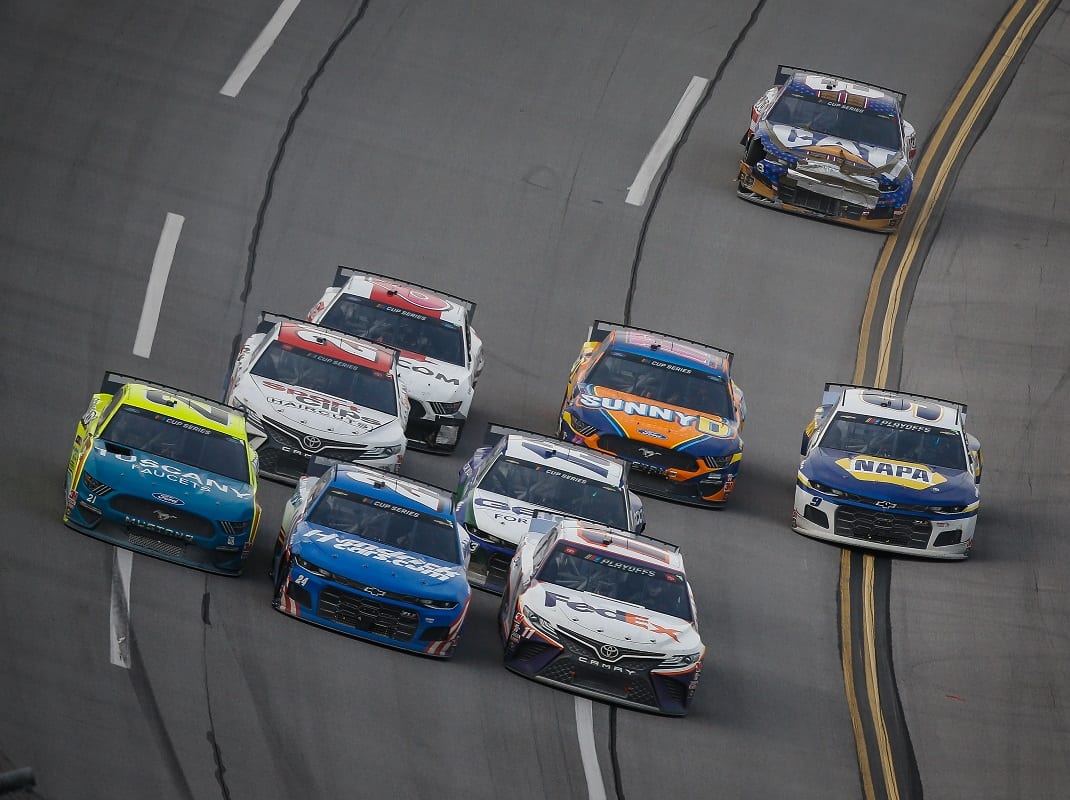TALLADEGA, Ala. — Despite a raucous outcry from fans on social media following the controversial finish to Sunday’s YellaWood 500 at Talladega Superspeedway, NASCAR senior vice president of competition Scott Miller saw no room to debate the outcome that ended with Denny Hamlin in victory lane.
Matt DiBenedetto, who initially crossed the finish line second to Hamlin, was hit with a penalty after the race for forcing the Chevrolet of William Byron below the double yellow “out-of-bounds” line.
Chris Buescher was also penalized for a similar transgression after appearing to capture a top-five result. The penalties relegated DiBenedetto and Buescher to 21st and 22nd, respectively.
They were the final two penalties called in a race that featured multiple interventions from race control, including two instances where Joey Logano was penalized for forcing competitors out of bounds.
Miller told reporters after the race that, in his eyes, the last lap “was pretty clear‑cut.”
“The 21 (DiBenedetto) hung a left, (and) drove those guys down below the line,” Miller noted. “We called that twice on the 22 car during the race, so nothing different there. On the 24 and the 11 being down there … I mean, in our judgment they were down there to avoid a wreck.
“I think all of it was, from our vantage point, I think fairly clear‑cut.”
Sunday’s race was a wild affair, with 58 lead changes among 18 different drivers and a track-record 13 caution periods, including two major multi-car accidents that each led to 10-minute red-flag stoppages.
But eventual runner-up Erik Jones, who inherited second place after DiBenedetto’s final-lap penalty, mused that it would likely have been an even crazier affair if there wasn’t a distinct out of bounds line.
“I think you’d probably see more wrecks without it, guys just being able to dive down there and trying to make big moves. You’d probably see more accidents,” said Jones of not having a rule on the double yellow line. “I don’t know – I don’t honestly know what to do to make it better.
“It’s unfortunate when it comes down to the end of the race, and it becomes a judgment call.”
Third-place runner Ty Dillon agreed, adding that he doesn’t feel the rule needs to be altered and that the state of superspeedway racing comes down to the aerodynamic package that’s in place.
“These cars are a bit easier to drive, stuck to the ground harder,” Dillon explained. “The runs are happening twice as fast as they ever have. You’ve got guys going below the yellow line, you’ve got guys going for a win, and you’ve got guys not trying to wreck.
“Guys have a lot of things going on in their mind (in the race car). Sometimes when you go below the yellow line, it’s not totally your fault, but it is the rules. It comes down to a mental decision, one of ‘am I going to lift or go below the yellow line?’” he continued. “We all know the rules before we get here. I think if you were to open it up and take the yellow line away, you’re going to have guys blocking all the way down to the grass, and then you’d have twice as big of wrecks.
“I don’t think we want to open up that can of worms. We have plenty of race track we can go four‑ or five‑wide on. It’s a product of what we do. I don’t see anybody at fault for any reason. I don’t think anybody tried to bend the rules to get an advantage. I think it’s just a product of what happens here.”
Despite numerous violations of the double yellow line rule Sunday, Miller closed his comments by pointing out that he doesn’t believe there is much more that NASCAR can do to keep the situation from happening again, except for continuing to penalize offending drivers until the message is clear.
“Outside of putting a wall there, I don’t really know what more we can do. I do sincerely believe we need the (yellow line) rule,” Miller noted. “You see all the real estate that’s around here. If we started having cars running 12 wide down the back straightaway, imagine what would happen when we got to turn three. So I think it’s important that we continue to have a rule. You get out there in the heat of battle, things happen. It’s hard when there’s all that real estate down there, but you just can’t do it.
“I don’t think that we can eliminate it. I think it would be a mess. We kind of are where we are.”
